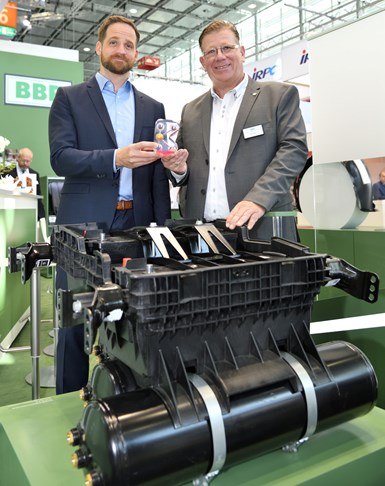Composite truck component carrier from Lanxess wins GKV/TecPart Innovation Award
Injection-molded glass fiber-reinforced PA6 component is jointly developed with system supplier and truck manufacturer for 35% less weight, replaces DLFT-based design.
This truck component carrier made from a Lanxess PA6 compound has won the 2022 GKV/TecPart Innovation Award presented by Verband Technische Kunststoffprodukte e.V. Photo Credit: BBP Kunststoffwerk Marbach Baier
A truck component carrier made from a Lanxess (Cologne, Germany) polyamide 6 (PA6) compound has won the 2022 GKV/TecPart Innovation Award presented by Verband Technische Kunststoffprodukte e.V. (Frankfurt, Germany) at K Show in Düsseldorf, Germany. The structural component, jointly developed by BBP Kunststoffwerk Marbach Baier (Marbach am Neckar, Germany), Lanxess and an unnamed German commercial vehicle manufacturer is a Durethan BKV35H2.0 901510 PA6 compound reinforced with 35 weight percent short glass fibers.
“Our material and our comprehensive process and structural simulations have helped to ensure that the carrier does not have to be reinforced with heavy and expensive metal inserts, in contrast to a direct long fiber thermoplastic [DLFT] composite design variant based on polypropylene,” Dr. Matthias Theunissen, an expert in lightweight design in plastics application development at Lanxess, says. “As a result, the component is around 35% lighter and much cheaper to manufacture.”
The component carrier is used in multiple truck models and takes the form of a trough with a cover. It is fastened to just four points at the center of the truck’s ladder frame and performs a number of tasks. For example, it holds two batteries weighing 75 kilograms each, as well as three compressed-air tanks, each of which tips the scales at around 7 kilograms. The structural component is exposed to considerable acceleration forces of approximately 1.2 million kilometers over a vehicle service life. These dynamic forces, plus the high weight of the entire assembly and the small number of fastening points, mean that it is subject to significant mechanical loads, Lanxess notes.
To obviate the need for costly metal reinforcement, BBP and Lanxess worked together to devise concept ideas for a purely injection-molded component that would be capable of withstanding high dynamic loads. In addition to design proposals, Lanxess contributed its expertise in simulations for structural component design. One particular challenge along the way was fastening the component to just a few points on the ladder frame and designing these fastenings to be capable of bearing the necessary loads.
Horst Hauke from BBP (right) and Matthias Theunissen (left) from Lanxess receive the award for the jointly developed innovative truck component carrier. Photo Credit: Lanxess
“When we were making the calculations, we had the benefit of being able to draw on our extensive process expertise in matters of injection molding. For example, we used a process simulation to determine how the short glass fibers orient themselves locally during injection molding, which leads to direction-dependent mechanical component properties,” Frank Lutter, CAE specialist, Lanxess, explains. “We then fed the data from that into the structural simulation, which helped to make precise predictions about the mechanical behavior of the component and, in turn, to optimize it.”
Injection molding the carrier is said to offer a number of advantages over DLFT-based manufacturing. For example, fiber orientation, wall thickness and warpage are all easier to reproduce. Production also lends itself better to automation, and cycle times are shorter and more efficient.
Related Content
The making of carbon fiber
A look at the process by which precursor becomes carbon fiber through a careful (and mostly proprietary) manipulation of temperature and tension.
Read MoreSulapac introduces Sulapac Flow 1.7 to replace PLA, ABS and PP in FDM, FGF
Available as filament and granules for extrusion, new wood composite matches properties yet is compostable, eliminates microplastics and reduces carbon footprint.
Read MoreRecycling end-of-life composite parts: New methods, markets
From infrastructure solutions to consumer products, Polish recycler Anmet and Netherlands-based researchers are developing new methods for repurposing wind turbine blades and other composite parts.
Read MorePlant tour: Joby Aviation, Marina, Calif., U.S.
As the advanced air mobility market begins to take shape, market leader Joby Aviation works to industrialize composites manufacturing for its first-generation, composites-intensive, all-electric air taxi.
Read MoreRead Next
Lanxess equips SUVs with Tepex dynalite underbody paneling
Robust thermoplastic panels are 30% lighter than steel designs, features higher resistance to stone impacts or other damage, indicating future applications in electric-, hydrogen-powered vehicles.
Read MoreComposites end markets: Energy (2024)
Composites are used widely in oil/gas, wind and other renewable energy applications. Despite market challenges, growth potential and innovation for composites continue.
Read MoreFrom the CW Archives: The tale of the thermoplastic cryotank
In 2006, guest columnist Bob Hartunian related the story of his efforts two decades prior, while at McDonnell Douglas, to develop a thermoplastic composite crytank for hydrogen storage. He learned a lot of lessons.
Read More













.jpg;maxWidth=300;quality=90)














